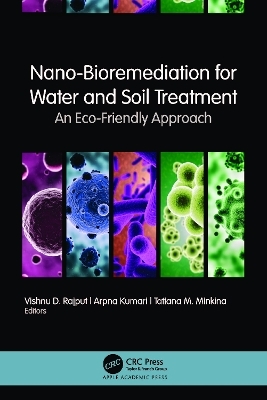
Nano-Bioremediation for Water and Soil Treatment
Apple Academic Press Inc. (Verlag)
978-1-77491-486-1 (ISBN)
This new volume addresses the global concern of environmental pollution mediated by a variety of organic, inorganic, persistent, and nonpersistent pollutants, which have a substantial detrimental impact on the structural and functional aspects of ecosystems. The book presents some important and recent nanotechnological advances that provide significant potential for decontamination of many polluted sites. It first provides the introductory background of nanoremediation and then delves into applications for the restoration of environmental sites that have been contaminated with a diverse range of pollutants, such as heavy metal, pesticides, and dyes in soil and water.
This volume improves our knowledge of nanotechnology-based remediation to make it less hazardous and reusable. It provides valuable information on the decontamination of the soil and water resources.
Vishnu D. Rajput, PhD, is an Associate Professor at Southern Federal University, Russia. His research is on the toxic effects of bulk- and nano-forms of metals and the bioaccumulation on bio/geo-transformations on plant physiology, morphology, anatomy, ultrastructure of cellular and subcellular organelles, cytomorphometric modifications, and DNA. He is also researching remediation approaches such using biochar/nano-biochar-based sorbents and nanotechnology. With Dr. Rajput has published 16 books and over 325 scientific publications. He is an internationally recognized reviewer and is an editorial board member of several high-impact journals. He is a co-principal investor on several grants on the state of contaminated soils and plants using synchrotron methods and other related areas. Arpna Kumari, PhD, is affiliated with the Academy of Biology and Biotechnology, Southern Federal University, Russia, as a senior researcher, and with the University of Tokyo, Japan as a Postdoctoral Fellow under the JSPS Standard Fellowship program. Her research experiece is in plant science with an emphasis on abiotic stressors, stress mitigation strategies, applications of nanotechnology in sustainable agriculture and contaminated soil restoration, and cytotoxicity and genotoxicity of emerging pollutants and endocrine disruptors. Currently, she is dealing with plant nutrition. She has published over 70 scientific publications and has presented her research at many national and international conferences. She is also a reveiwer of many journals. Tatiana Minkina, PhD, is the Head of Soil Science and Land Evaluation Department of Southern Federal University, Russia. She is Head of the International Master’s Degree Educational Program "Management and Estimation of Land Resources". Her scientific interest is in soil science, biogeochemistry of trace elements, environmental soil chemistry, soil monitoring and assessment, and modeling and remediation using physicochemical treatment methods. She has published over 750 papers. Dr. Minkina was awarded a Diploma of the Ministry of Education and Science of the Russian Federation for her many years of work on the educational process and for her significant contribution to the training of highly qualified specialists.
1. Introductory Overview of Nanobioremediation 2. Nano-Phytoremediation: An Emerging Sustainable Reclamation Technique 3. Microorganisms, Plants, and Nanotechnology for Environmental Remediation: A Sustainable Prospect 4. Nanomaterials-Assisted Decontamination of Various Pollutants from Water Resources 5. Nanomaterials-Assisted Decontamination of Heavy Metal from Water Resources 6. Nanomaterials for Inorganic Pollutants Removal from Contaminated Water 7. Applications of Nanomaterials in the Restoration of Aquatic Ecosystems 8. Remediation of Heavy Metals from Contaminated Soils Using Nanomaterials and Hyperaccumulator Plants 9. New Dimensions into the Removal of Pesticides Using an Innovative Eco-Friendly Technique: Nanoremediation 10. Nanoremediation: A Promising Reclamation Method for the Removal of Organic Pollutants from Different Environmental Sites 11. Nanobioremediation of Metal and Salt Contaminated Soils 12. Nanotechnological Approaches for Restoring Metalloid Contaminated Soil 13. Removal of Dyes by Nano-Bioremediation: Importance and Future Aspects 14. Nanoremediation: A Sustainable Reclamation Method for Future Deployment
| Erscheinungsdatum | 13.06.2024 |
|---|---|
| Zusatzinfo | 26 Tables, black and white; 11 Line drawings, color; 7 Line drawings, black and white; 4 Halftones, color; 3 Halftones, black and white; 15 Illustrations, color; 10 Illustrations, black and white |
| Verlagsort | Oakville |
| Sprache | englisch |
| Maße | 156 x 234 mm |
| Gewicht | 789 g |
| Themenwelt | Naturwissenschaften ► Geowissenschaften ► Geologie |
| Technik | |
| Weitere Fachgebiete ► Land- / Forstwirtschaft / Fischerei | |
| ISBN-10 | 1-77491-486-7 / 1774914867 |
| ISBN-13 | 978-1-77491-486-1 / 9781774914861 |
| Zustand | Neuware |
| Informationen gemäß Produktsicherheitsverordnung (GPSR) | |
| Haben Sie eine Frage zum Produkt? |
aus dem Bereich


